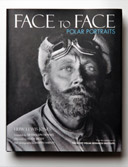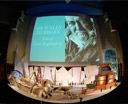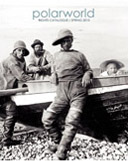 Our ProductsOur Resources |
This website requires the free Flash plugin to be installed.
Polarworld - discover more polar booksThe Arctic Book Review Historical Atlas of the Arctic Historical Atlas of the ArcticDerek Hayes Reviewed by Russell A. Potter The role played by maps in our collective fascination with the Arctic is impossible to overstate – indeed, our very idea of the Arctic is that of a circled point, near to the magical zone where all the lines of longitude converge. Yet up until now, there has been no readily-available book which has compiled the complex, semi-fantastical, and often fatal history of Arctic maps. Derek Hayes's Historical Atlas of the Arctic fills that gap, and admirably so; it is without question the most wide-ranging, visually stunning, and historically grounded collection of Arctic maps ever assembled. This is no mere collocation of modernized schemata, as so many historical atlases tend to be, but a highly significant and thoughtfully organized series of primary source documents, including numerous hand-drawn maps and charts, colored engravings, and illuminated manuscripts. Where else could one find John Dee's original map of Frobisher's discoveries, Ikmalick and Apelagu's strikingly accurate map of Ross's "Gulph of Boothia," and Robert McClure's hand-drawn chart of Banks and Victoria Islands, all within a single, stunningly-printed volume? Yet the marvelous maps – more than three hundred of them – are only part of the value of this book. Derek Hayes has provided a running account of the voyages, expeditions, and geographical notions which produced and motivated these maps, and the text alone is one of the best concise histories of Arctic exploration I've read. Hayes, like Pierre Berton, does not hesitate to exercise modern judgments of historical maps, and while some traditionalists may take offense, I found his candidness refreshing. In a note, for instance, to the "Gulph of Boothia" map drawn by Inuit, Hayes observes that Ross, "in perhaps the ultimate act of Eurocentrism," referred to the map's makers as "Boothians, " since, after all, "they lived in the country he had named after the gin magnate." Hayes also deftly dances through controversial mapping claims, as with Peary's to have traveled the entire last dash to the Pole along the 70th meridian – after all his camps and trail would have moved by the time he returned – but judiciously steers clear of any absolute conclusion on the matter. An atlas, after all, is a work of reference, though as Hayes amply documents, many atlases and maps before were produced quite deliberately to support some theory or another about the Pole. Most dramatic is the illustration "Discovery of the North Pole and the Polar Gulf Surrounding it," which depicts a mile-high iron cone surrounded by a perfectly circular ring of ice, as "discovered" by one John Shelden in 1869! The saga of Augustus Peterman, who doggedly produced (and reluctantly revised) a long series of maps purporting to prove the existence of an Open Polar Sea, forms, in Hayes's hands, another quite droll yet cautionary tale. A lengthy section on the search for Sir John Franklin is one of the book's highlights, giving as it does the charts originally sent with Franklin's ships, followed by the numerous new discoveries which proved them false. A minor criticism here: the chart said to be the one sent with Franklin is in fact a reproduction of an illustration from an 1860 book, and not John Arrowsmith's actual chart; the differences are minor but could mislead those looking for a detailed sense of Franklin's geographical knowledge. Hayes's book also covers an astonishing range of time, beginning as it does with the world map of Macrobius from 1485 and continuing through the IBCAO digital map of 2001, which launched the era of dynamically-updated online topographic maps, compiled from international mapping bodies, satellite photographs, and oceanographic scans. In more than five centuries, we have certainly made enormous progress in our geographical knowledge of the North, and can produce charts of remarkable accuracy of any features in the region. Yet, as this book amply demonstrates, errors are, in the long run, even more fascinating than corrections – in the long march to full and accurate mapping, more than half the fun was in getting there. |
|
||
follow us  | join us | join us  | home | contact | home | contact
|
||||
|
© Copyright Polarworld Ltd
SiteWizard.co.uk Web Site Design Company |
||||


